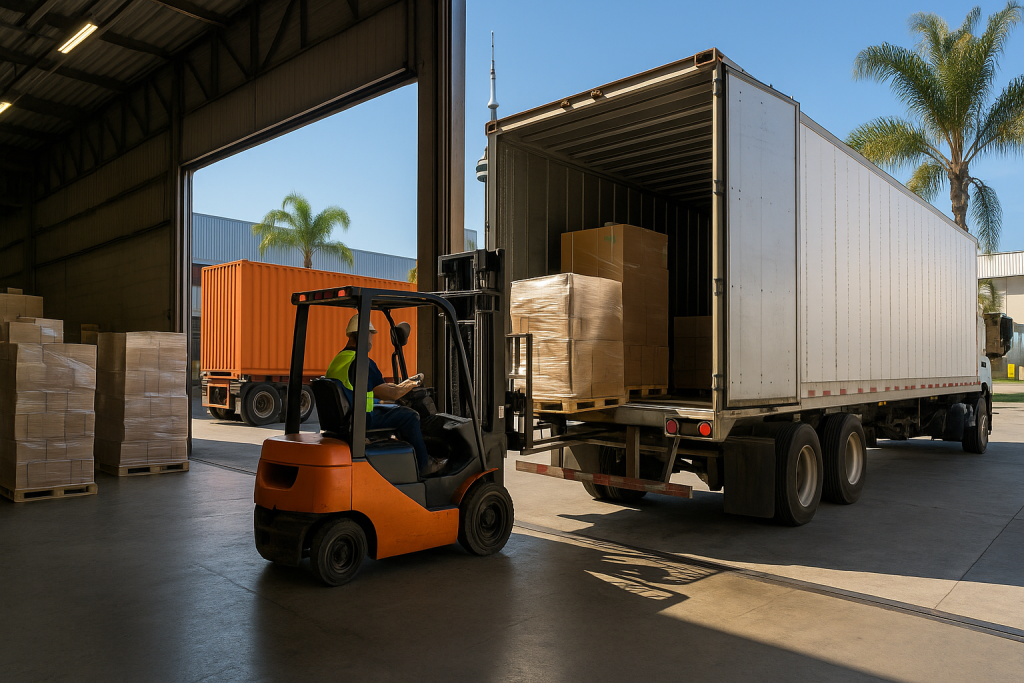By Martin Vassilev / 17 Sep, 2025
In today’s retail environment, where customer expectations are shaped by same-day delivery promises and international e-commerce platforms, businesses can no longer afford inefficiencies in their supply chains. Cross-docking, a logistics strategy that eliminates or minimizes warehousing by transferring goods directly from inbound trucks to outbound transportation, has become a cornerstone of modern supply chain efficiency. Toronto and Los Angeles—two of North America’s most influential logistics hubs—are leading examples of cities where cross-docking plays a vital role in supporting retail growth, speed, and profitability.
Cross-docking refers to the process of unloading products from inbound freight, sorting them, and loading them directly onto outbound vehicles. Unlike traditional warehousing models, inventory spends minimal or no time in storage. This system is particularly valuable for retailers dealing with fast-moving goods, seasonal demand, and multi-channel distribution networks.
Toronto, with its access to the Canadian market and U.S. trade routes, and Los Angeles, as the busiest container port in North America, are natural epicenters for cross-docking operations. Together, these cities enable seamless domestic and cross-border supply chains for retailers across North America.
Retailers in competitive markets cannot risk delays. Cross-docking ensures goods spend less time sitting idle, reducing delivery cycles by up to 50%. For example, apparel companies importing products through Los Angeles can move inventory from ports directly to distribution trucks without warehousing, getting products on store shelves or to customers faster.
Warehousing costs can quickly erode profit margins. By minimizing the need for long-term storage, businesses lower expenses on rent, utilities, and labor. Retailers using Toronto-based logistics partners benefit from streamlined distribution across Ontario and into U.S. markets with fewer overhead costs.
Modern cross-docking centers in Los Angeles and Toronto leverage real-time tracking systems. Retailers gain instant visibility of shipments, which supports customer satisfaction and better decision-making. This aligns with trends explored in real-time tracking in delivery services, where transparency drives consumer trust.
With fewer handling steps, the likelihood of product damage or theft decreases. This is especially critical for high-value retail products such as electronics or luxury goods.
Retail supply chains in Toronto and Los Angeles use various cross-docking models depending on business needs:
Pre-Distribution Cross-Docking – Goods are pre-labeled and pre-assigned to specific customers or stores before arriving at the dock.
Post-Distribution Cross-Docking – Sorting happens after arrival, offering flexibility when demand forecasting is uncertain.
Continuous Cross-Docking – High-demand products move continuously between inbound and outbound trucks without stopping.
Opportunistic Cross-Docking – Ideal for seasonal surges in retail, such as holiday shopping in Toronto or back-to-school demand in Los Angeles.
Toronto sits at the crossroads of Canadian commerce and provides seamless access to both local and U.S. distribution networks. Its proximity to major retailers and warehouses makes it an ideal hub for regional supply chain optimization. Businesses considering logistics in Ottawa often integrate Toronto-based cross-docking to enhance coverage across Eastern Canada.
The Port of Los Angeles processes millions of TEUs annually, making it indispensable for retailers importing from Asia. By cross-docking goods at facilities near the port, businesses avoid storage delays and move products swiftly across U.S. states.

Advanced technology plays a defining role in making cross-docking efficient:
Automated sorting systems reduce manual labor.
AI-driven forecasting predicts demand spikes and allocates resources effectively, a trend highlighted in AI logistics innovation.
Data analytics tools optimize routing, helping businesses meet customer demands with precision.
This transformation mirrors broader logistics trends like warehouse automation where robotics and real-time data drive smarter supply chain decisions.
While the benefits are significant, retailers must also prepare for challenges:
High Upfront Investment – Setting up cross-docking facilities requires capital for equipment, staff, and technology integration.
Supplier and Carrier Coordination – Effective cross-docking relies on synchronized operations across multiple stakeholders.
Limited Use Cases – Not all products are suitable. Perishable goods and high-demand retail items benefit most, while slow-moving products may not.
These obstacles highlight the importance of strategic planning, much like the steps discussed in supply chain optimization strategies.
E-commerce giants like Amazon have normalized two-day or same-day delivery, forcing retailers to adapt. Toronto and Los Angeles logistics partners use cross-docking to serve both brick-and-mortar and online channels, ensuring seamless omnichannel fulfillment. This approach improves customer satisfaction and loyalty while cutting last-mile delivery costs.
Retailers in Los Angeles often face holiday demand spikes. By leveraging cross-docking, they bypass bottlenecks in warehousing and move inventory directly to regional stores. Similarly, in Toronto, retailers managing winter clothing shipments ensure shelves are stocked quickly without burdening warehouse capacity.
Both cities offer strategic advantages in compliance. For example, U.S. Customs and Border Protection at Los Angeles port enables quick clearance for international shipments. Meanwhile, Toronto retailers benefit from streamlined Canadian logistics regulations supported by resources like Government of Canada’s trade and customs guidelines.
The future of retail supply chains will be defined by automation, AI, and sustainability. Cross-docking will evolve with:
Automated robotic loading systems
AI-powered predictive analytics
Eco-friendly distribution hubs
These align with broader logistics innovations such as green logistics strategies, ensuring that cross-docking remains sustainable while meeting growing consumer demand.
Cross-docking is no longer just a competitive advantage—it is a necessity for modern retail supply chains. Toronto provides unparalleled access to the Canadian and U.S. markets, while Los Angeles anchors global imports into North America. Retailers who integrate cross-docking can reduce costs, improve speed, enhance visibility, and build resilience against disruptions.
For businesses seeking to enhance their supply chain performance, investing in cross-docking within these two hubs ensures long-term growth, efficiency, and customer satisfaction. To explore tailored logistics strategies, visit our contact page and connect with our experts.

“Thanks to Byexpress all my shipping and fulfillment costs are in line now”

“All my issues were solved by Byexpress team that I had with pervious 3pl provider.”

“Thank you Byexpress team could not done it without you guys.”

“Their integration and customer service were the key for me”

“Outstanding delivery service! The package was well-packaged, and
the delivery team was professional and courteous”

“Great and knowledgeable team to work with.”

Thanks, guys, for reducing my shipping rates
Ottawa Office
2411 Holly Lane
Ottawa, ON, K1V 7P2
Toronto Office
13-280 West Beaver Creek Road Unit #136
Richmond Hill, ON, L4B 3Z1
Alexandria Office
173 Kenyon Street West
Alexandria, ON, K0C 1A0
Montreal Office
4388 Saint-Denis Street Unit #200
Montreal, QC, H2J 2L1
California Office
155 North Riverview Drive
Anaheim Hills, CA, 92808
Call Us
Toll-Free: 1-866-744-7122
Local : 613-739-3000
Email Us
Multilingual Services










